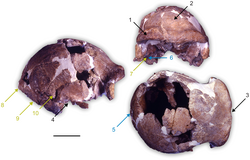Homo cepranensis
|
Homo cepranensis Temporal range: , 0.5–0.35 Ma |
|
|---|---|
 |
|
| Holotype skull | |
| Scientific classification | |
| Kingdom: | Animalia |
| Phylum: | Chordata |
| Class: | Mammalia |
| Order: | Primates |
| Family: | Hominidae |
| Genus: | Homo |
| Species: | H. cepranensis |
| Binomial name | |
|
†Homo cepranensis Mallegni et al., 2003 |
|
Homo cepranensis is a proposed name for a species of the genus Homo known from a single skull cap (calvaria) discovered in 1994. The fossil was accidentally unearthed in a highway construction project. Although damaged by a bulldozer it was recognized, documented and described by archeologist Italo Biddittu, who happened to be present when the nearly complete hominin calvaria came to light, nicknamed "Argil" by its discoverer and "Ceprano Man" after the nearby town Ceprano in the province of Frosinone, 89 kilometers Southeast of Rome, Italy.
The generally morphological robust find shows peculiar characteristics, especially in the frontal bone and has no equivalent in Europe or elsewhere, its taxonomic status has been so far controversial as it differs from the other hominid species H. ergaster, H. erectus, and H. heidelbergensis. The results of morphometric and cladistic analyses and comparisons with other fossils lead to the conclusion that this fossil is a distinct hominid species.
The holotype (see image) of Homo cepranenis has a unique combination of morphological features: 1: incomplete sulcus supraorbitalis, 2: frontal tuber weakly developed medially shifted, 3: supraorbital region medially concave, 4: intermediate position of the external auditory meatus in regard to the processus zygomaticus temporalis); 5 and 6 (blue) = more derived traits (i.e. 5: straight torus occipitalis transversus, 6: medio-lateral concavity of the articular tubercle); 7 to 10 (green) = more primitive traits (i.e. 7: petro-tympanic crest orientated downward, 8: opisthocranion coincident with inion, 9: processus retromastoideus, 10: torus angularis parietalis
The fossil was first estimated to be between 690,000 to 900,000 years old determined on the basis of regional correlations and a series of absolute dates. After clarification of its geostratigaphic, biostratigraphic and archaeological relation to the well known and nearby Acheulean site of Fontana Ranuccio, dated to 487,000 +/- 6,000 years, Muttoni et al. suggested that Ceprano is most likely 450,000 years old - the mid of the . Taking the circumstances of the recovery of the fossil into account A. Ascenzi states in 2001: "...given the absence in the sediments containing the cranium of any leucitic remnants of the more recent volcanic activity known in the region—that are referred to the range between 100 and 700 ka and the presence above the cranium itself of a clear stratigraphic unconformity that marks the lowest limit of the sandy leucitic pyroclasts, an age between 800 and 900 ka is at present our best chronological estimate.[sic]"
...
Wikipedia
